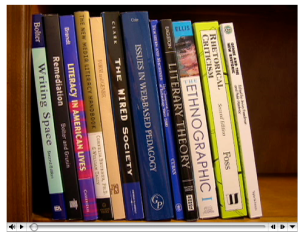Values & Criteria Analysis–The Real Part 2
Using the heuristic we’ve crafted in class, I was able to examine Rykia’s awesomely entertaining “The Batman Complex” video clip.
Content

Here is an example of the creator's use of contrast to illustrate the distinction between reality and the dream-scape
The content in this video flows exceptionally well; the edits are flawless, the transitions almost like liquid. There are no awkward juxtapositions and hardly any overlap. The only time elements overlap is when they have to in an effort to buffer the overall story. More than that, text along with audio and video are blended together. Title screens help move the story along and add to the cinematic drama. There is no need for different perspectives, but several are offered. Just imagine how many different story lines you can craft from this author’s work of blending about six different movies together?
Ethics/Responsible Use

Above is the media's blending of text with video media. Titles screens such as these help illustrate sequences and drive the trailer's plot
Entertainment
I feel that our crafted heuristic does fit with the “This is Scholarship” media piece almost as equally well as it does for the “The Batman Complex” video.
Content
The video flows fluidly as well, without any weird juxtapositions. The text and video elements blend together while also being broken into distinguishable scenes. In this case, the creator(s) use digital, online and print-based media to drive home their point and they do a good job of it.
Ethics & Responsible Use
The work is obviously very original and I’m sure it took a long time to produce. With their inclusion of computer screens, online catalogs, online periodicals, Google Scholar, JSTOR and other devices as characters in the

Here is an example of media elements converging on one plane. There's printed text, video text and--if you were playing the video--audio.
piece, the creator(s) manage to completely and fully cite their material. There’s even audio attribution toward the end of the video as the woman explains the new media philosophies adopted by several institutions and universities. The media manages to generate a thought-provoking reaction just by explaining the significance of new scholarly media.
Interactivity
The media manages to be interactive in pretty much the same way “The Batman Complex” adopts its own interactive hypertexts. Users are able to pause, play, rewind and fast forward the video–giving them a modicum of control over their viewing activity.
Demographics & Entertainment
This media also manages to use a combination of humans and inanimate objects to create an overall lesson. This media does have a specific audience–academics, or those affected by academia. Any college student, professor or innovator in pedagogy will want to pay attention to this media because they are bound to learn that, in the face of the digital revolution (or movement, whichever you prefer), the way scholarship and research are performed is undergoing a paradigm shift.
Audio/Visual Quality
I like how, towards the end of the video, the creator(s) interrupts what users would take as the normal structure of the media and inserts a woman’s voice. It was unexpected. Though this is no cinematic or action-packed media example like “The Batman Complex,” the creator(s) knows his/her/their audience well. People who watch things on videos need to be engaged; they need to stay in tune with what they’re watching, otherwise they become bored and disinterested. The inclusion of the woman toward the video’s close is a nice touch that I feel buffers the point of the video. Behold, a new type of scholarship:

Here is one of my favorite touches with this video--the inclusion of a woman's voice as actual audio. Here, the creators use the audio recording and editing software Audacity to show the audio in action, so to speak.-
Final Analysis:
Because these two types of media are so different in their intentions, it may at first seem difficult to examine them as corollaries. Yet, I posit that the heuristic–in its questions about genre, entertainment, rhetorical strategies and ethics–manages to cover enough broad ranges that most new media pieces could probably be evaluated by these criteria.Both “This is Scholarship” and “The Batman Complex” tell a story; both have intriguing layout and design; both use visual and audio cues to enhance the viewer’s experience; both are entertaining enough that they provoke thoughtful reactions and allow for some reflection; both are skillfully created and edited. The only main difference, other than their pop-culture vs. academic genres, is that “This is Scholarship” creator(s) manages to more carefully cite his/her/their material and attribute his/her/their sources.
Leave a comment